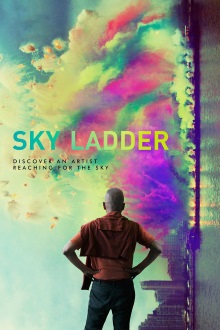
I’m sure that most people on the Internet came across images of the famous 1,650-foot ladder of burning gunpowder climbing towards the sky when it made the rounds a couple of years ago. This is a documentary about the life and career of the Chinese artist, Cai Guo-Qiang, behind that project. When I first saw those images I was impressed but thought that it must be the work of some enterprising fireworks technician. As this film shows however, Cai truly is an artist whose output spans multiple media.
A fairly standard documentary about an artist, Sky Ladder covers Cai’s entire career, beginning with his childhood in Quanzhou, Fujian Province. He recounts a story about how his father, a calligrapher and scholar, never brought home any money and instead spent all that he had on books. Cai’s own artistic inclinations seems to have been quite obvious early on but he didn’t seem to have established himself until he went to Japan to study, experimenting with using gunpowder to create paintings. His first major project seems to have involved extending large structures like the Great Wall of China with fireworks. At the same time, he also made more traditional indoor installations that were displayed in the US. Perhaps his best known work was his involvement in the impressive fireworks display for the Beijing Olympics in 2008. The documentary frames the Sky Ladder project as the culmination of many years of work as it had been planned for several earlier events but always got put off due to weather or safety concerns. In the end, he held it in his hometown as a tribute to his origins and a gift to his grandmother.
Cai is of course both a showman and an artist and there’s a fair bit of posturing here to make him look good. For example the way he speaks of the Sky Ladder project as honoring his hometown and his grandmother actually feels self-aggrandizing to me. Still his artistic achievements are undeniable and at least he seems relatively frank in his comments in this film. He acknowledges that in his youth life in China was difficult and so he did everything that he could to leave the country. The documentary also raises the question of why Cai decided to cooperate with the Chinese government for the Olympics and other projects and whether doing so counted as compromising on his artistic integrity. The question is especially pertinent given that Cai’s own father was forced to burn many of his books to escape persecution during the Cultural Revolution. Cai doesn’t quite give a straight answer here, claiming that artists of every country do the same and there is nothing wrong with a Chinese artist helping China for what amounts to its coming out party. Surprisingly one of his former staff members outright admits that the work was purely commercial and a result of compromising with the sensibilities of the government.
Video is probably a poor substitute for experiencing his work in person. His gunpowder trails seem a bit pointless to me to be honest and it’s hard to appreciate the paintings he makes using explosions without looking at them close-up. The larger installations, such as the one that uses colored powder to create patterns in the air, however look suitably impressive. The Sky Ladder seems like such a simple concept with the framework for the ladder simply being held up by a hot air balloon, but it makes for a majestic sight as it clambers up into the sky. I especially appreciate how the documentary crew kept filming the aftermath of the Sky Ladder presentation, showing the reactions of the various participants and resulting in some shots which feel surprisingly intimate. Cai’s wife for example had complained earlier about the cost of the project so seeing her in tears as she watched the ladder is rather moving.
I don’t consider this to be a particularly groundbreaking documentary but it does what it sets out to do well enough to introduce an important artist to a wider audience. One may debate whether or not Cai’s work has any deeper meaning but there’s no denying their visual impact or his current status in the art world.